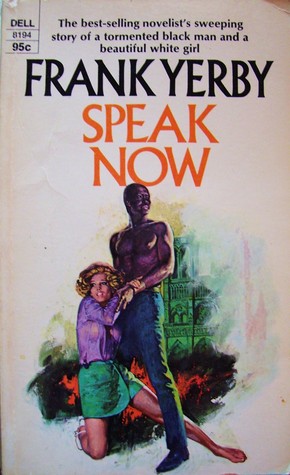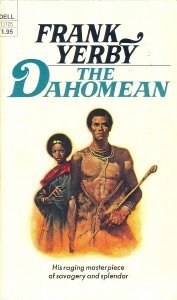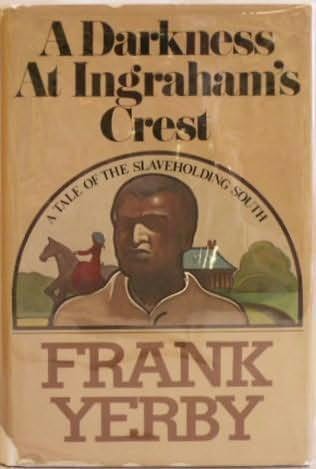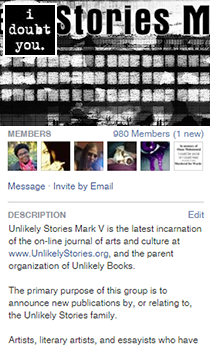Frank Yerby’s Challenge to the Myth of White Southern Womanhood
A couple of years ago, I slipped into the local library’s annual book sale determined to leave with bags full of books for a miniscule amount of money. While looking at the rows and rows of collected texts before me, I decided to start at the rare, first edition books. There, I came across a couple of books by Frank Yerby, a name I had heard of but never read. I picked the books up, took them home, and placed them on my shelf. Over the course of a couple of more annual book sales, I picked up more novels by Yerby, taking them home, and placing them on my shelf.
 Fast forward a couple of years, and on a trip to New Orleans in September 2015, I wandered into one of my usual haunts in the Vieux Carre and found Yerby’s Speak Now (1968), a novel that, from its cover, countered all of Yerby’s “costume romances” that occupied my shelf at home. Speak Now was the first Yerby book I read, and as such, it provided me a view of the author that went against the blanket idea that Yerby did not write anything that challenged the predominant views in American consciousness relating to race during the mid to latter part of the twentieth century.
Fast forward a couple of years, and on a trip to New Orleans in September 2015, I wandered into one of my usual haunts in the Vieux Carre and found Yerby’s Speak Now (1968), a novel that, from its cover, countered all of Yerby’s “costume romances” that occupied my shelf at home. Speak Now was the first Yerby book I read, and as such, it provided me a view of the author that went against the blanket idea that Yerby did not write anything that challenged the predominant views in American consciousness relating to race during the mid to latter part of the twentieth century.
Eventually, I would pick up Yerby’s first novel The Foxes of Harrow (1946), a text that on the surface placates white readers while subversively challenging their views in regards to race. Even though he sold millions of copies of his 33 books, many critics have viewed Yerby as nothing more than a pulp novelist who wrote pot boilers for money and nothing more. Robert Bone famously called Yerby the “prince of pulpsters” (176). However, some challenge that view, commenting on Yerby’s subversive undertones and his rewriting of Southern Romances like Margaret Mitchell’s Gone With the Wind (1936). In 1968, Darwin Turner, while knocking Yerby for his plot construction and other “artistic weaknesses,” points out that the Augusta, Georgia, born author “attacked America, in particular the South” through his books (570, 572).
During my last trip to New Orleans, I stopped by Librairie Bookshop on Chartres and picked up four more Frank Yerby paperbacks: The Saracen Blade (1952), Gillian (1960), The Man from Dahomey (1971), and A Darkness at Ingraham's Crest (1979). Since then, I have been delving, in earnest, into Yerby's oeuvre and continually noticing the subversive elements that exist beneath the surface of his "costume romance" that appears to reinforce the mythological ideal of a romantic South. Ultimately, we should view Yerby as a counter voice to dominant ideas of a nostalgic South, specifically regarding white Southern women.
Maligned during his life and after his death by critics, Yerby's work needs to be reexamined and explored in the ways that it strives to deconstruct false mythologies of the South. To do that, we need to look at Yerby's life's work as a whole, not just at his novels. This includes poems and short stories that he wrote and got published before he made it big with The Foxes of Harrow. These texts are, for a lack of a better term, protest writings. They directly challenge the hegemonic system that maintains its power and control over blacks. Through his white, female characters Yerby deconstructs the myth of white Southern womanhood, a myth that arose out of the late eighteenth and nineteenth century Cult of True Womanhood, or The Cult of Domesticity. Originating in Puritan New England, the Cult of True Womanhood became evident in the South during the nineteenth century, and beyond, and existed as a way to maintain race and class distinctions because black women were not allowed to be conceived of as women because they supposedly did not adhere to the four pillars of "true" womanhood: piety, purity, submission, and domesticity. Barbara Welter explains that these four pillars, when joined together, “spelled mother, daughter, sister, wife-woman. Without them, no matter whether there was fame, achievement or wealth, all was ashes. With them she was promised happiness and power” (152).
Yerby counters this myth from the very beginning of his career, specifically in his short story "White Magnolias," a piece that originally appeared in 1944 in Phylon. The story (only about seven pages) focuses on Beth Thomas, a white teenager, asking her black friend Hannah Simmons over to her house for tea. Beth's parents do not want Hannah in their house because she is black, and the main focus of the story centers on the debate that Beth has with her parents about Hannah's humanity. Eventually, Hannah appears and a verbal confrontation occurs between Beth's parents and herself. Bruce A. Glasurd and Laurie Champion argue that "White Magnolias," along with Yerby's other short stories, need to be reevaluated because "Yerby, as did Chester Himes, attempted both to reach and to teach about the evils of the current race situation in the United States; this approach makes his stories both politically effective and tragically ignored" (16).
From the title of the story, Yerby draws our attention to the symbol of the magnolia and its reference to both the South and specifically white Southern womanhood. The story begins with Clint Thomas, Beth’s father, telling his daughter, “The magnolia is like a high born lady of the old South Beautiful and refined and - delicate - like your Mother” (319). At the outset, Yerby seeks to question the “ideal” white Southern woman, and does this through Beth’s reactions to her father’s comparisons of Martha Thomas to a magnolia. Beth counters her father by pointing out that Martha “can wear down a houseful of servants and run you ragged” and that she does not have anything in her head except for “trivia” (319). Immediately following this exchange, the subject shifts and Beth asks her father for a cigarette, going against the respected mores of a white Southern womanhood.
By positioning the discussion of the magnolia and its connection to white Southern womanhood at the outset of the story, Yerby asks us to question what exactly we should take away from the beauty and meaning of the magnolia as a symbol. Counter to its beauty, the appearance of the magnolia recalls similar images of magnolia's in Billie Holiday's "Strange Fruit" and Langston Hughes's "Magnolia Flowers." While the magnolia, in Holiday, Hughes, and Yerby, contains elements of beauty, violence lurks underneath. The scent of magnolias in "Strange Fruit" becomes overwhelmed by "burning flesh," the magnolias that the speaker looks for in "Magnolia Flowers" turn up a dead body that the speaker trips over, and the magnolias that line the Thomas's walk in "White Magnolias" hide the hostility and cruelty behind the veneer of beauty that Clint and Martha Thomas supposedly embody.
In "White Magnolias," Yerby comments on the false “sophistication” of the South and on the barriers to upward mobility by African Americans in the region. Even though Hannah's father is a well-respected doctor in the community, her brother is at Harvard, and she has a degree from Fisk and plans to attend Boston University for postgraduate work, Beth's mother and father see her as nothing more than a servant. From the very beginning, Beth's parents cannot believe that Beth wants to share the table with Hannah, and her mother even thinks that Beth wants Hannah to serve her food. As such, even though Beth tells her parents that her and Hannah are friends, Martha tries to get Hannah to work for the family as a maid: "How'd you like to come to work for me? Just for the summer I mean - or longer if you'd give up this foolish notion about postgraduate study. I have the feeling you'd be quite a treasure" (323). Clint and Martha do not see her, or her family, as equals. In fact, Clint tells the group gathered on the porch, "But let me tell you - all the money and all the education in the world won't make a white man out of a nigger! All it does is to make the critter miserable. Wanting things he never can have. Forgetting he's black and trying to act white. Getting into all sorts of trouble—" (324).
Beth's parents believe the "race problem" has been solved a long time ago, because "[t]he South solved it years ago. Treat the Negro kindly, but keep him in his place" (321). That place, as Beth's parents espouse, is subservient to whites. The magnolias represent this social hierarchy, and they take center stage from the opening of the story when Clint tells Beth about the beauty of the magnolia and its relation to white Southern womanhood, and as Hannah comes up the walk near the middle of the story, she looks up at the magnolias and tells Beth, "I hate magnolias. . . They always meant something to me—something unpleasant—like useless beauty that can't even stand a breath. But I'm being silly. They really are beautiful, aren't they?" (322). For Hannah, the magnolias, while beautiful, maintain something hideous underneath. As a symbol of the “idyllic” South, the magnolias represent to Hannah the oppression and subjugation her and her family endure because of the color of their skin.
While Hannah knows the fabricated reality represented in the magnolias, a reality that refuses to include her as a Southern woman, Beth has to learn about what exists beneath the surface. After fighting with her parents and talking with Hannah, Beth realizes the falseness of the Southern myth as well. At the end of the story, when Hannah says that the magnolias "are lovely," Beth starts to think back to an "idyllic" South with the smell of jasmine and magnolias in the air as women is hoop skirts move about the landscape (325). However, she stops halfway through her thought and realizes the deceptiveness of her vision. Rather than seeing women in hoop skirts, she sees "only the long line of black men and women in their faded rags moving between the stalks of the cotton. And the auctioneer was holding open a black man's mouth to show his fine teeth. And the slow heartbreaking songs rose up from the little cabins and the stench of black flesh drowned out the jasmine" (325). Here, Yerby undercuts the beauty of the magnolias with the stench of death in the same way that "Strange Fruit" and "Magnolia Flowers" do. At the end, Beth takes a magnolia flower from the tree and tears "the heavy, waxen petals into shreds," thus destroying the mythic image of the South that existed in her mind (326).
In the opening of the story, Beth counters the ideas of white Southern womanhood through her speech and her request for a cigarette; however, it is not until the end that she realizes the true nature of the constructed ideas that her parents seek to protect and maintain. Throughout his novels, Yerby does not approach this level of blatant pushback against the “idyllic” South until later in his career. While the undercurrents exist from the earliest novels, he does not confront the myth of white Southern womanhood head first until his 1971 novel The Dahomean and its follow-up, A Darkness at Ingraham’s Crest (1979).
 The Dahomean (1971) stands, to many, as the author's best novel. Still an historical novel, like most of Yerby's other works, The Dahomean differs from his previous novels because it focuses on black characters, specifically African characters. Speak Now (1968) does center on an African American expatriate in France, but it also deals overtly with race relations in Europe and America. The Dahomean focuses entirely on African characters and their lives in Dahomey. With The Dahomean, Yerby relied on the research found in Melville J. Herskovits' Dahomey: An Ancient West African Kingdom (1967) to write the novel. Ultimately, he sought "to correct, as far as possible, the Anglo-Saxon reader's historical perspective" and to prove that "[m]yths solve nothing, arrange nothing" (5, 6). Yerby accomplishes this by relating the story of Hwesu's life in Africa before he gets sold into slavery at the very end of the novel.
The Dahomean (1971) stands, to many, as the author's best novel. Still an historical novel, like most of Yerby's other works, The Dahomean differs from his previous novels because it focuses on black characters, specifically African characters. Speak Now (1968) does center on an African American expatriate in France, but it also deals overtly with race relations in Europe and America. The Dahomean focuses entirely on African characters and their lives in Dahomey. With The Dahomean, Yerby relied on the research found in Melville J. Herskovits' Dahomey: An Ancient West African Kingdom (1967) to write the novel. Ultimately, he sought "to correct, as far as possible, the Anglo-Saxon reader's historical perspective" and to prove that "[m]yths solve nothing, arrange nothing" (5, 6). Yerby accomplishes this by relating the story of Hwesu's life in Africa before he gets sold into slavery at the very end of the novel.
The Dahomean contains many aspects (class, slavery, reality versus belief, reversal of beauty, etc.) that warrant further exploration, especially in regards to Yerby's representation of Dahomean culture. Perhaps one of the most interesting aspects of the novel is how Yerby continues his arguments against the mythic South and its view on white virginal womanhood in a novel that contains very few white characters. Stephanie Brown notes that since The Foxes of Harrow Yerby populates his book with miscegenation because he understood “the obvious—that blackness and whiteness are inseparable in American culture—with the overwhelming acceptance of ordinary readers” (75). This thought becomes apparent in The Dahomean when Hwesu interbreeds horses.
Horses, typically, "were miserable racks of bones" in Dahomey, and if they were strong, they would die quickly due to the flies and diseases. When Hwesu's father Gbneu brings a strong Auyo stallion home, he laments that the horse will die within a few months (246). Hwesu proposes that they mate the Auyo stallion with one of the bony mares in the stable. This way, there would be "hope [that] the colt, having half the blood of a dam accustomed to the tsete flies, will live--" (247). The stallion died before the colt, N'yoh (It is good), arrived, but the new colt "proved to be even more beautiful than his sire" (247).
Hwesu eventually loses N'yoh to the king of Dahomey, something he expects to happen seeing that N'yoh is the finest horse in the kingdom. However, Hwesu does not view this loss negatively because he learns that "no less than three of the mares had foaled since his departure from Alladah," and the colts survived and grew strong (317). These colts, along with N'yoh, show the strength of intermingling. Throughout The Dahomean, European culture intersects with Dahomean culture in various ways, most notably through references to trade. Likewise, the struggles of class, government, and religion that pepper the novel have correlations to European culture. By having N'yoh, and other colts, sired through a joining together of Dahomean and Auyo horses, Yerby, underneath a narrative surface that does not provide European characters, presents something for us to think about.
The intermingling of cultures, and the benefits of the contact, comes into full view in the follow up A Darkness of Ingraham's Crest. In that novel, there are two interracial relationships that seek to escape the Southern mores and customs that keep them from marrying one another. Mixed-race siblings Joe and Ellen Collins have relationships with Abigal Collins and Dwight Ingraham respectively. The desire of each couple to marry presents a joining together of cultures that will strengthen society. Through this conjoining, specifically with Ellen and Dwight who escape North to Boston and marry, the idea of the Cult of True Womanhood excluding blacks gets shattered because Ellen becomes a devote, submissive, and pure wife. These relationships mirror, in some ways, what Charles Chesnutt proposed in "The Future American" almost eighty years before. Along with the interracial relationships, A Darkness of Ingrahams's Crest shows the contact between a white southern planter class and Hwesu (now Wesley “Wes” Parks).
At various points in the novel, Wes's display of his African culture, especially in his dress and actions, leads the whites to see the humanity in their human property. This becomes especially evident during Wes's arranged marriage to Phoebe, another slave. For the wedding, Wes sewed traditional Dahoeman clothes and made traditional Dahomean jewelry for Phoebe to wear during the ceremony. When the whites gathered at the Christmas Day wedding see Phoebe, they start to question their own perceptions of those they keep enslaved. They think,
[F]or if a nigger wench could be this lovely, move with this grace, display this kind of noble, deep, refined and tender feeling, the emotional foundations upon which they'd built their world, the bedrock convictions that enabled the absolute contradiction of their maintenance of slavery to coexist with a proud and stubborn self-respect, would begin to slip and slide along subterranean geological faults deep in their flinty psyches, to bring that world crashing to utter ruin. (274).
Being an African sold into slavery, Wes introduces both the slaves and their owners to his culture. Along with this, he takes on aspects of the American culture by learning to read, learning about the environment, and studying law. He joins his past with his current surrounding to make him stronger. This mixture causes him to point out the absurdity of the slave system to those who seek to uphold it, and in essence, he embodies the mixture that produces N’yoh in The Dahomean.
 While A Darkness at Ingraham’s Crest contains discussions and examples of amalgamation between cultures, Yerby’s main thrust is to dismantle the mythological ideal white Southern woman. This becomes obvious with the discussions that the white characters have regarding their own white women and those they oppress. Tolbert Weatherbee questions if Ashton Bibbs actually "believe[s] all that undiluted crap about Southern womanhood" before he defines it at length:
While A Darkness at Ingraham’s Crest contains discussions and examples of amalgamation between cultures, Yerby’s main thrust is to dismantle the mythological ideal white Southern woman. This becomes obvious with the discussions that the white characters have regarding their own white women and those they oppress. Tolbert Weatherbee questions if Ashton Bibbs actually "believe[s] all that undiluted crap about Southern womanhood" before he defines it at length:
Our women, according to popular legend, are Ladies. And Ladies have ice water and pink lemonade in their veins. Ladies have not the faintest vestiges of carnal desire. They submit to their husbands out of a sense of duty-lying there perfectly still and waiting for said husbands-disgusting male animals, slaves to their baser instincts!-to get the whole incomprehensible and repugnant business over with as quickly as possible, because of that aforementioned sense of duty and because they maintain sufficient maternal instincts to want to have babies. (75-76)
Tolbert focuses his attack on the purity of Southern womanhood by arguing that the pedestal for Southern white women gets higher and higher because of miscegenation. He tells Ashton that the "roistering down in the quarters" doesn't benefit anyone, even though the community insists on "piously labeling it a safety valve that protects the Vestal Virgins we're courtin' or married to, from our baser natures" (77). What Yerby highlights, though, is that the “Vestal Virgins” do not need to be protected by anyone because they relinquish to their natural desires, expunging the thought of purity from their true identity.
Yerby further attacks this myth by having Pamela Ingraham, a New England woman who despises slavery at the beginning of the novel and marries into the planter class, as one of the central characters in the novel. (Pamela, eventually, becomes accustomed to the life of a plantation owner and becomes a cruel mistress to her slaves.) Pamela goes against three of the four pillars of the Cult of True Womanhood (piety does not really come into the novel) in her actions. Specifically, Yerby attacks the idea of the white woman's purity. While Pamela is an emigrate to the South, she becomes entrenched in the mores and customs of the region.
During her tryst with Tolbert, Pamela, while trying to get him to sleep with her, tells the lawyer, "I want to go bed with you. To lie warm and naked and ravished in your arms. . . . Unladylike. But I am not a Lady. I am me. A-female of the canine species-who-hates all the appallingly-dreadful things she is" (348). Pamela, like Gillian and Hero in Gillian, goes against the belief of white women of standing as "Vestal Virgins" devoid of sexual and impure desires. Pamela's desires, in fact, lead to the accidental death of her daughter Deirdre. As Tolbert and Pamela have sex, they hear a crash in the girl's room. Mid-coitus, Tolbert asks Pamela what the sound was, and she ignores him, twice, pushes him down on the bed and continues the act. Her actions, in the face of Tolbert asking her about the sound from Deirdre's room, highlights the extent that Pamela does not uphold the purity of Southern womanhood.
Along with Pamela, Yerby presents other white, Southern women as demythologizing forces. Specifically, the seventeen- year-old Ruth Collins counters the myth in her affair with the married Ashton Bibbs. After he takes her virginity in consensual sex, Ruth tells Ashton, "I want you to-to make love to me-again, And again and again and again and again! I don't want you to ever stop!" (303) As Ashton and Ruth continue making love, Wallace Bibbs, Ash's father, arrives at the cabin after being shot in the stomach. Wallace dismounts his horse in the rain and collapses before he can reach the door. Inside, Ahston and Ruth do not hear him, and they find him face down in the mud the next day. Wallace survives for a while but eventually dies the same night as Deirdre. Like Pamela, Ashton and Ruth do not recognize what happens because they are engaged in activities unbecoming of a "true" Southern woman.
"The survival of the South-my-South, the one I know and love," according to Ashton Bibbs in Yerby's 1979 novel, "depends upon the White man's being up, and the nigger, down" (418). The Cult of True Womanhood worked to maintain this hierarchy, constructing a binary that placed virginal aspects on white womanhood and oversexualized desires on blacks and others. Patricia Hill Collins argues that under "the cult of true womanhood" white women "were encouraged to aspire to these virtues" [while] African-American women encountered a different set of controlling images" (72). These images served, and continue to serve, as a counter to the “ideal” images of womanhood and provided whites with a way to maintain their control.
Hill Collins notes four "controlling images" placed on black women: the mammy, the matriarch, the welfare mother, and the jezebel. All of these images can be traced back to slavery and continue in today's culture; however, for our purposes here, we will focus on the jezebel, whose "function was to relegate all Black women to the category of sexually aggressive women, thus providing a powerful rationale for the widespread sexual assaults by White men typically reported by Black slave women" (81). Yerby attacks this image by presenting his African, African-American, and mixed-race characters as less sexually aggressive than his white female characters, specifically highlighting their chasteness, desire to wait until marriage to engage in sexual activity, and their aversion to adulteress encounters.
In The Dahomean, Yerby presents a narrative set entirely in Africa, placing the standards of the Cult of True Womanhood on African women like Agbale and Dangbevi. Each of these women uphold the virtues of purity and submissiveness that the Cult of True Womanhood sought to present as the ideal in America. Yerby does contrast these representations of womanhood with other African characters that do not uphold purity of submissiveness. While he does this in The Dahomean, the juxtaposition with white womanhood does not come through because there are no white female characters to compare and contrast the characters' actions with. However, A Darkness at Ingraham's Crest provides readers with characters that juxtapose one another in their actions and desires.
Counterpunctual to Pamela and Ruth, the black Phoebe and mixed-race Ruby present images of womanhood that more closely resemble the purity and submissiveness embodied in "the cult of true womanhood" and deconstruct the stereotypical image of non-white women. Before she marries Wes, Phoebe is a virgin, not engaging in any sexual activity (consensual or forced). After Phoebe leaves, because she becomes pregnant with Bob Bibbs's child after he rapes her, Ruby makes a play for Wes. Like Phoebe, Ruby is a virgin as well; however, she really wants to consummate her relationship with Wes. She teases him and tries to get him to sleep with her; however, she does not go to the extremes that Pamela does with Tolbert. Instead, when Wes refuses her advances, she submits to him, unlike Pamela.
Before marrying Bob, Pamela was already three months pregnant, and as she tells Tolbert, "[a] whore, . . . [a]t least at heart" (113). During her talk with Tolbert, Pamela seeks to dismantle the idol of true Southern womanhood. She tells the lawyer that her pregnancy did not occur because of rape or a lapse of judgement on her part; instead, it "was the result of-enough, frequently repeated-carnal sin to have endangered the Egyptian hosts" (113). Pamela admits her inability to live up the Cult of True Womanhood, and countered with her "carnal" actions, Phoebe and Ruby exist as models of purity, saving themselves until marriage and even disallowing men to see them naked before their wedding nights. Ruby admits to Wes that no man, not even her father, has seen her naked since she was eight or nine.
Phoebe continues to counter these myths even after Bob rapes her. After Bob forces himself on her, Phoebe tells her assailant she is going to kill herself the next day because she "promised th' Lawd I'd be faithful 'n true t' my man," maintaining her purity and submissiveness to Wes; she even insists that Bob turn around as she gets dressed (310). Her request to have Bob turn around, which he does, makes him feel ashamed and experience an "absolute hatred of self" (311). This rape needs to be looked at in relation to the rape of Pamela later in the novel. At this time, I do not have the space to look at these two incidents together; however, that would prove a fruitful examination.
Overall, Yerby does much more than placate a white readership through his representations of the South. Here, I have focused on his latter works, but the subversive questioning of the Cult of True Womanhood in regards to white Southern womanhood appears throughout his oeuvre. When reading any of Yerby’s texts, always keep in mind the undercurrents that exist just below the surface. He does not beat his readers over the head with his ideas like he does earlier with “White Magnolias.” Instead, he lets the narrative take control as he introduces readers to concepts that may run antithetical to their views. Yerby continuously questions the myth of the Southern past, and it is for this reason, amongst others, that we need to reevaluate him by reading his work.
Works Cited
Bone, Robert. The Negro Novel in America. New Haven: Yale University Press, 1958.
Brown, Stephanie. The Postwar African American Novel: Protest and Discontent, 1945-1950. Jackson: University Press of Mississippi, 2011.
Glasurd, Bruce A. and Laurie Champion. "'The Fishes and the Poet's Hands': Frank Yerby, A Black Author in Whitee America." Journal of American and Comparitive Cultures (2000): 15-21.
Hill Collins, Patricia. Black Feminist Thought: Knowing, Consciousness, and the Politics of Empowerment. 2nd Edition. New York: Routledge, 2000.
Turner, Darwin T. “Frank Yerby as Debunker.” The Massachusetts Review 9:3 (1968): 569-577.
Welter, Barbara. “The Cult of True Womanhood: 1820-1860.” American Quarterly 18.2 (1966): 151-174.
Yerby, Frank. A Darkness at Ingraham's Crest: A Tale of the Slaveholding South. London: Granada, 1981.
--. The Man from Dahomey: An Historical Novel. London: Mayflower Books, 1973.
---. "White Magnolias." Phylon 5.4 (1944): 319-326.

Matthew Teutsch is the Director of the Lillian E. Smith Center at Piedmont College. He maintains Interminable Rambling, a blog about literature, composition, culture, and pedagogy. He has published articles and book reviews in various venues including LEAR, MELUS, Mississippi Quarterly, African American Review and Callaloo. His research focus is African American, Southern, and American literature. He is the editor of Rediscovering Frank Yerby: Critical Essays (UPM 2020). Follow him on Twitter @SilasLapham.


